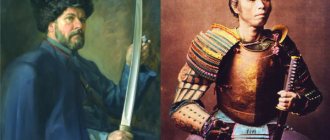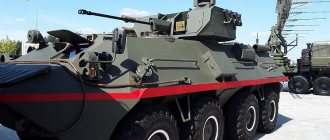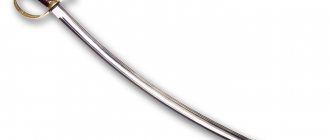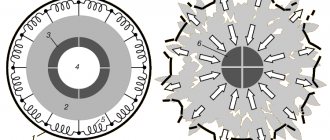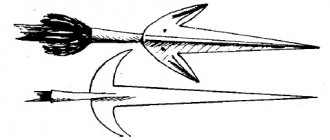History of creation
The name shashka comes from the Circassian language and literally means “long knife.” The first samples of weapons appeared no earlier than the 12th century. As firearms developed, the saber became more and more popular, gradually replacing sabers. The weapon was adopted by the Terek and Kuban Cossacks, and from them came into service with the Russian army.
The choice of the saber as a bladed weapon for arming the army was not accidental; in contrast to sabers and broadswords previously in service, the saber had a number of advantages:
- A simplified fencing technique available to most officers and lower ranks of cavalry units;
- Adaptability for delivering slashing blows;
- Lightweight production technology, including due to the design of the hilt.
The date of official adoption of the checker in Russia is 1881, when a commission headed by Lieutenant General A.P. Gorlov unified the types of weapons.
The basis of the new weapon was a blade of the so-called “Caucasian” type, which replaced other types of sabers and broadswords. The saber adopted for service had a number of modifications that were supplied to equip artillery and dragoon units. Among the weapon options are the following types:
- Cossack model of a checker, which had a normal length, one fuller and a regular hilt without a bow;
- A dragoon-type blade, equipped with one fuller (a recess on the side of the blade) and distinguished by a modified hilt, which had a bow in its design;
- Officer's Cossack saber, equipped with a blade shortened by 100 mm with three side fullers. The modernized version of the 1910 model has a reshaped hilt with an increased angle of the handle and a thicker central part. The monogram of the emperor was affixed to the end of the handle, during whose reign the owner of the saber received an officer rank. Zlatoust factories produced the Cossack officer's saber of the 1913 model, which was intended for use by officers of the Cossack Caucasian troops. This type of weapon was produced in a small series and today has a collector's value;
- An artillery version, having a length similar to the officer's weapon, but only one dollar.
In addition to these options, checkers of the 1834 and 1839 models remained in service, which were equipped with hilts made of black horn or with brass coating. To arm the Caucasian Cossack units, a saber of the 1904 model was used, which had two halves in the handle design, riveted with several rivets.
After the October Revolution, a combat saber with a blade of the 1881 model went into service with the Red Army.
At the same time, for the command staff, weapons with a dragoon blade were relied upon.
In 1927, the weapon was slightly modernized and remained in service until the disbandment of the cavalry units, which occurred in the 50s of the last century. Subsequently, checkers were used as reward weapons, so they were produced in single copies.
From 1940 to 1949, there was a version of the ceremonial weapon, which was used by combined arms and artillery command ranks (not lower than general).
Since 1998, the production of this type of weapon has resumed. The blade began to be used as a weapon in the revived Cossack units. A considerable number of checkers produced are supplied in the form of souvenir or anniversary products and sold through gun stores.
One of the famous manufacturers of checkers is the Don Arms Factory, which produces several types of checkers of the 1881 model. Decorative stands are used to store Cossack sabers. Several factories in Russia produce toys in the form of wooden Cossack checkers.
STATUTORY COSSACK CHECKERSA saber is a cutting-and-piercing long-bladed bladed weapon. Initially, the Russian irregular cavalry was armed with a Caucasian-type saber, which had a blade with a slight curvature and a hilt consisting of one handle with a bifurcating head, without any protective devices. A typically Caucasian hilt can be considered one of the main distinguishing features of the saber as a type of bladed weapon. A characteristic difference between a checker and a saber has always been the presence of a wooden scabbard, covered with leather, with a ring (less often with two rings) for the belt's passing belts on the convex side (that is, it was hung along the caucasus with the blade backwards), while the saber's rings are always on the concave side side of the scabbard. In addition, a saber was often worn on a shoulder belt, and a saber on a waist belt.
The Caucasus has long been inhabited by numerous warring tribes, and from a very early age, weapons became a companion that accompanied a man throughout his life. The ability to wield it made it possible to occupy a higher social level in society and simply save life. Therefore, the choice of weapons was given paramount importance.
In ancient times, when bows were used, from which it was possible to conduct a fairly intense firefight, warriors for close combat armed themselves with sabers with blades 1 m or even more long. The Caucasian version of the blade of such a saber was slightly curved (like the sabers of ancient steppe nomads) and had a narrow long tip of the blade, adapted for penetrating stabbing blows. Since the 16th century, the tip of the blade of many of these sabers began to be designed in the form of a reinforced (thickened) narrow faceted tip with the help of which, with sufficient impact force, it was possible to break the ring of chain mail and hit the enemy. This innovation came to the Caucasus from Persia or Turkey, where by this time specialized daggers of this type had appeared, specifically designed for piercing protective armor. The combination of such a dagger with a long-bladed weapon corresponded to the fighting technique cultivated by the mountaineers of the Caucasus and is the merit of Caucasian gunsmiths. “The points of their swords (of course, sabers, although rare examples of straight blades with such a faceted point are known - later examples of combined weapons dating back to the 19th century) are similar to the points of tetrahedral or trihedral spears. Appearance in the XVII-XVIII centuries. In the Caucasus, firearms changed combat tactics. Effectively hitting an enemy protected by chain mail, the gun gradually eliminated the use of this type of protective armor, and at the same time the use of a specialized saber. In addition, a weapon with an extremely long blade could not be quickly removed from its sheath, and after the shot the enemy, knowing for sure that the weapon was not loaded, instantly rushed into close combat. And in this situation, only “sashkho - long knife” could help out , as this name is translated from Adyghe (or Kabardino-Circassian, since the Turks and Crimean Tatars called the Adygs Circassians and the Russians, having come to the Caucasus, began to call them the same). “Sashkho” among the Russians turned into “saber”, and already in this sound the term came to Europe. Russian officer F.F. Tarnau, in the 30s. 19th century, who fought in the Caucasus, recalled: “... the most terrible Circassian weapon consists of a saber strip in a wooden, morocco-covered sheath, with a handle without protection for the hand. It is called “sazhenshkhua” - a large knife, from which we made the name of the checker... The Circassian checker is sharp, like a razor, and is used only for striking, and not for defense; saber strikes are mostly fatal”... [1, 10, 11].
Russian army samples of checkers (for example, the Dragoon model of 1881) differed from the Caucasian type checkers in the design of the hilt and scabbard.
The dragoon saber had a protective bow on the hilt (for lower ranks) and an additional device on the scabbard, where a rifle bayonet was attached. In the Cossack units, the hilt was without a bow, but with a “jib” - they decided to keep it, paying tribute to tradition.
The blades of the first army sabers had medium curvature and were close in shape to sabers.
The hilt was initially supposed to be of a single model, with protection by the front arch, but then it was decided to leave traditional hilts consisting of one handle for Cossack checkers. As a result, the following were adopted by the Russian army: - Cossack (officer and soldier) saber (Fig. 1); — dragoon (officer and soldier) saber (Fig. 2); - artillery saber - received a shortened version of the dragoon saber. Fig.1. Cossack saber
| Fig.2. Dragoon saber |
The classic checker is the following design: the blade of the checker is steel, slightly curvature, single-edged, at the end of the blade it is usually double-edged, with one wide fuller or several narrow ones (Fig. 3, 4).
| Rice. 3. Cossack saber [10] 1 - tip, 2 - butt, 3 - blade, 4 - fuller, 5 - heel, 6 - handle, 7 - lanyard, 8 - sheath tip, 9 - sheath, 10 - nut (clip) , 11 – mouth of sheath |
| Rice. 4. Dragoon saber: 1 – guard, 2 – tip of the handle [10] |
The point is the place where the blade connects to the butt of the blade or (on a double-edged blade) the blade to the blade. The tip causes puncture injuries.
The butt is the blunt edge of the blade opposite the blade. Markings may also be found on the butt.
Blade - a sharp edge of a blade that is used to cause chopped or cut injuries.
Fullers are longitudinal grooves in the form of grooves on the side surfaces of the blade to lighten its weight without reducing strength.
The heel is the unsharpened part of the blade near the tang. Stamps, numbers and other markings are usually placed on the heel.
Handle - designed for ease of use with the blade; the dimensions, shape and position of the handle relative to the blade depend on the type and type of bladed weapon.
Lanyard - from the Tatar temlik - a loop, cord or brush on the hilt of a bladed weapon. It has been widely used on long-bladed weapons since knightly times. A lanyard in the form of a loop is put on the hand and serves to prevent the loss of the weapon when it is released from the hands. A lanyard can be a mandatory part of a military uniform, as well as an insignia on a decorated weapon.
The scabbard tip is a metal part on the bottom of the scabbard that protects it from premature wear.
A sheath is a case for a blade. They are made from different materials. Often decorated in various ways. They may have a metal device consisting of a mouth, clips and a tip;
Nut (clip) - a metal plate that encircles the sheath in the middle part and serves to attach the sheath to a sword belt, belt, etc. A metal ring is usually attached to the clip;
The mouth of the sheath is a metal part that covers the upper part of the sheath, where the blade is inserted;
Guard - a metal part in the form of a bracket, located in the plane of the blade on the blade side (for weapons with a long blade) and connecting both ends of the handle.
The tip of the handles (closing nut, head, knob, etc.) is the part with which the handle of the weapon ends [1, 10].
1. Asian pattern checker 1834
For a long time, the Cossacks were armed with their great-grandfather’s sabers and sabers, Turkish, Persian, Hungarian and other weapons of Asian origin. Until the middle of the 19th century, the Cossacks had especially many Caucasian sabers. The first attempt to somehow regulate the armament of Cossack units occurred in 1834-1838.
1.1. Soldier's sword, Asian model, 1834
The blade is steel, curved, single-edged, with one wide fuller. The combat end is double-edged (Fig. 5).
The hilt consists of one handle. The handle is wooden, with a forked head, in which there is a hole for a lanyard. There is a metal sleeve on the bottom of the handle.
Wooden scabbard covered with leather. The metal device consists of a mouth and four nuts. The first and third nuts with rings for the belt belts. On the second, third and fourth nuts there are sockets for a bayonet, until the 1870s. triangular, from the 1870s. tetrahedral. The scabbards of the sabers of non-commissioned officers and trumpeters (more than 100 in the regiment) are not named after bayonet sockets, since this category of lower ranks was armed with pistols (later revolvers).
Total length is about 1000 mm. length about 880 mm, blade width up to 34 mm, blade curvature on average 70/395 mm, weight about 1400 g.
| Rice. 5. Asian-style soldier's checker, 1834 [10, 17] |
In 1834, the saber replaced cavalry sabers among the lower ranks of the Nizhny Novgorod Dragoon Regiment. In 1858, it was assigned to the lower ranks of the Seversky Dragoon Regiment, formed in 1856. In 1881, the Asian sabers of the 1834 model were replaced in the Nizhny Novgorod and Seversky Dragoon regiments with Cossack sabers of the 1881 model, but in 1889, a reverse replacement took place [1, 10].
In 1891, these checkers (without bayonet sockets on the legs) were assigned instead of Cossack checkers to sergeants of the Plastun battalions and local teams of the Kuban Cossack army.
Subsequently, these checkers were adopted to replace the dragoon ones: in 1901 - in the Tver Dragoon Regiment, in 1903 - in the Pereyaslav Dragoon Regiment and the corresponding marching squadrons of the 7th Reserve Cavalry Regiment, as well as in the Novorossiysk Dragoon Regiment.
In the above-mentioned regiments and units, these checkers were in service until the end of the period under review [1, 10].
1.2. Asian officer's sword, 1834
The officer's saber differed from the soldier's in that it had arbitrary decorations on the hilt and scabbard. Since 1834, it was introduced and was in service with officers of the same units as the soldier’s saber of the Asian model of 1834.
Material of manufacture
The classic material for making a blade is considered to be high-carbon steel, forged and heat-treated using a special technology. There are samples of weapons made from Damascus steels or alloy steels produced by the Obukhov plant. Such blades were produced until the end of the 19th century and were produced in single copies or in small series.
The often mentioned damask steel was not used for the manufacture of serial checkers.
However, due to the tradition of ordering personal edged weapons from craftsmen, damask sabers were quite often found among officers of the Russian army and Cossack troops.
A characteristic feature of all blades is a bend with a slight curvature and the presence of double-sided sharpening near the tip. An exception may be products from Central Asia, which have a greater curvature of the blade.
There are fullers on both side surfaces of the blade. In the case of using several fullers, one of them has a larger width and is located next to the sharpened edge of the blade. By using several fullers, the rigidity of the blade increased, since the spaces between them acted as reinforcement ribs.
Award checkers
Rewarding military achievements with weapons became a tradition in Russia in the 18th century. Award weapons were divided into two types: edged weapons for generals and officers and granted weapons for the Cossacks. Such weapons were decorated with gold or diamonds, complementing the image with an engraved inscription. A place was allocated for the inscription on the hilt. The most common expression: “For courage.”
Before the First World War, golden weapons were abolished, equating them with the Order of St. George. The decorated Cossack saber began to be called the St. George weapon. The photo with the award received became a family heirloom. In addition to the St. George's weapon, they were awarded Annin's sabers. They were dedicated to Saint Anna, daughter of Peter the Great, and were considered lower in ranking.
Design features and wearing method
The classic saber is a full-fledged edged weapon. It consists of two main elements:
- Blade;
- Handles.
The blade has a slight bend, and its length is approximately equal to a meter. The handle does not have a protective guard, since this weapon is not intended for fencing. The confusion between a saber and a saber is due to the fact that these weapons come in two types:
- The first includes Asian and Cossack checkers;
- The second included dragoon modifications that had a protective bow.
Cossack weapons copied not only the appearance of Asian checkers. The fighting technique was also significantly redesigned, since with the development of firearms, fencing gradually became irrelevant.
The checker was worn with the blade up, since it was from this position that the blade could be taken out and struck in one movement, which gave an advantage in battle.
Sabers of the Eastern countries
Asian culture is associated primarily with the Ottoman Empire. In Medieval times, they had serious armed conflicts with European states. Sabers arrived in Europe as war trophies. They were occasionally imported by traders during short truces.
The most common and famous sabers at that time were the kilij saber from Turkey and the Persian shamshir. They have a greater blade bend than the European versions and the shape of their hilt is typical of eastern sabers. The hilt guard did not have shields or bows, but was like a regular crosspiece, the handle was a regular pistol type.
Eastern saber.
Weapon parameters
The combat checkers had the following parameters:
- The standard length could reach a meter, but, as a rule, ranged from 70 to 90 centimeters;
- The blade was about 40 mm wide, although some Caucasian models had a blade 30 mm wide;
- Often the blades were decorated with engraving. Blades were produced in Kizlyar or Zlatoust, although in any mountain village a blacksmith could forge the simplest version for poor mountaineers;
- The blades of Caucasian weapons, as a rule, had fullers, which were not at all intended for blood drainage. Their purpose is to reduce weight and strengthen the blade from breaking.
The checkers that were produced for the Russian Tsarist army were of several types;
- Dragunskaya;
- Cossack combined arms;
- Artillery;
- Cossack officer's;
- A transitional look between the Cossack and dragoon models.
We must pay tribute to the Cossacks, who completely adopted the style of wielding sabers from the highlanders. In contrast, Russian officers often cut with sabers like sabers, negating almost all the advantages of the weapon.
Cossack sabers
Cossack culture is closely connected with edged weapons. In the 15th century there were the first mentions of Cossack troops. In the 16th century, the Cossacks used a “klych” type saber or a copy of the Kievan Rus saber. They captured them in military campaigns or bought them from the Turks and nomadic peoples.
The Persian saber shamshir, made of damask or Damascus steel, was considered the best.
Only rich Cossacks could afford such specimens. But often these sabers were taken in battle; they were captured. The Adamashka saber was considered even no less valuable.
But this word was used to describe all crooked eastern sabers that were made from Damascus steel. The main attribute of a free Cossack was considered to be a saber. It was carefully preserved and passed on by inheritance. The Cossacks honed their fighting techniques on nomadic peoples. The Cossacks decorated the handles of their sabers with images of animals and birds, which served as a talisman.
Cossack saber shamshir
Description of the main elements of checkers
Real Caucasian weapons consist of the following parts:
- Point. This is the place at the top of the blade where the butt connects to the blade. It is the tip that is intended for piercing blows;
- Butt. The unsharpened edge of the blade, which is located on the other side of the blade;
- Blade. The sharp part of the blade, which is used for chopping blows;
- Doly. Special grooves on the blade, which serve to lighten the weapon and at the same time strengthen the blade;
- Heel. The part of the blade that is located near the tang;
- Handle. The part of a weapon that serves to hold it;
- Lanyard. A special loop, which is designed to prevent the loss of weapons in battle;
- Sheath. A case for carrying and storing the blade. Often has a metal tip on its bottom;
- Scabbard clip. A special metal plate that serves to attach the sheath to the belt;
- Garda. A part that protects the hand from enemy blows. Absent on traditional checkers.
Various models of checkers differed from each other in shape and size.
Our works
We produce a number of historical models of weapons, trying to expand the range. Most samples are in stock, popular samples are made on a first-come, first-served basis (waiting time does not exceed 1-2 months). Pay attention to the features of the checkers we produce.
The hilt in different models is made:
- cast (from brass or nickel silver);
- wooden (with metal rivets);
- combined (wooden handle, cast decorations).
Plastic/artificial leather is not used in production.
A lanyard is included in the package and price of some models; if desired, it can be purchased separately. All checkers presented in our store are sold together with a sheath, which is included in the purchase price. We do not produce separate sheaths for them, because they are made for a specific blade.
Differences between Cossack and Caucasian checkers
Cossack checkers have weapons similar to them, which are called Caucasian checkers. But they have several main differences:
- The weight of a Cossack saber is 1 kg, a Caucasian one is 300-400 g.
- The thickness of the Cossack blade is less than that of the Caucasian one.
- The Caucasian handle has bows, while the Cossack handle does not.
- The checkers of the peoples of the Caucasus had deep longitudinal pits, which were made in order to make the weapon lighter.
Based on this, it is believed that there are no particular critical differences, and the weapons are not inferior to each other in terms of convenience and functionality. Is it possible that based on how much a Cossack saber weighs, the Caucasian saber is lighter and because of this it may be somewhat more convenient.
Using checkers in the modern world
The production of Cossack sabers continues to this day. Most often this happens as a collection or gift, either for some competition or as part of a Cossack costume for a celebration or performance. You can build such a present according to the drawings of Cossack checkers yourself, but if you have certain skills, or order it from specialists. An original Cossack saber costs a lot and is difficult to find.
The most expensive among the checkers is the Cossack forged checker. Since this model is from 1881 and therefore difficult to obtain. The same can be said about the ordinary Cossack saber. They are usually used as a reward for high-ranking officials or true connoisseurs of this type of weapon. But forged Cossack military checkers are mainly given to the military and true connoisseurs of this weapon.
How the Cossack saber was and is used
Many ordinary people consider the Cossack saber to be a type of sword or saber. But despite the strong external similarity, it is difficult to consider them close relatives. Classic long-bladed weapons are intended for fencing - alternating attacks and defenses, searching for vulnerable areas of the enemy. Their blades are specially balanced for specific purposes in battle. What makes the checker stand out against their background?
- Due to the absence of a massive pommel that acts as a counterweight, the center of gravity of the checker blade is shifted closer to the center. Usually it is located 25-35 centimeters from the handle, while for swords and sabers the mass of the blade part is smaller and is close to the mass of the handle. Such a distribution of weight makes the checker unsuitable for blocking blows;
- The blade has either a slight curvature (like later sabers) or is completely devoid of it. Combined with the low weight, this precludes the effective use of even saber defensive and attacking techniques;
- The absence of a hilt or crosshair negates the practical possibility of defense using the strong part of the blade. This also makes piercing blows more difficult - the striker’s hand runs the risk of slipping onto the cutting edge. Serious injury to the fingers and complete loss of combat capability are guaranteed.
What made the checker so popular with all these shortcomings? The answer is obvious - all conditions are ripe for her on the battlefield.
In the 16th and 17th centuries, battles changed irrevocably. Armor finally lost out to firearms and began to disappear from the fighters. The fighter's first weapon was a muzzle-loading rifle. It was the handling of it that received all the attention in the fighter’s training. There was no point in fencing in battle - all that was needed was to deliver a crushing quick blow to the enemy. And in this the saber had no equal. A dashing Cossack, having unloaded a gun or pistol, had to defeat the enemy in close combat with a powerful lightning strike. The heavy blade of the checker made it possible to break through any blocking. At the same time, there was no need for defense - the outcome of the fight should be decided in the very first moment. A good Cossack did not need a second blow, as well as protection.
Another advantage of the checker was the way it was worn. The checker is attached to the shoulder or waist belt on the left side with the blade up, like a Japanese katana. This allows you to remove it from its sheath in one motion and deliver a diagonal slash from left to right. It is this movement - striking with the sheath - that is the most popular and basic technique of Cossack techniques. The speed of its implementation is what is developed first. Real masters are able to deliver a full-fledged fatal blow in tenths of a second, long before the enemy can react. In this case, wrist techniques are not used - it is extremely difficult to manipulate such an unbalanced weapon with just one hand. The blow is delivered from the shoulder with the entire body.
Such weapons made it possible to prepare a fighter much faster and place him on the battlefield. This is clearly demonstrated by the first written source that has survived to this day, which contains instructions on how to handle a saber. The Cossack Service Charter of 1889 mentioned only three techniques:
- Horizontal strikes;
- Vertical strikes;
- Prick to the left.
To successfully fight the enemy, the Cossack did not need anything more. One should not assume that a decrease in wielding techniques is a sign of weapon degradation. Quite the opposite: without reducing its effectiveness, the saber was easier to handle than broadswords and sabers. In addition, the Cossacks themselves, over time, developed many training methods, bringing seemingly elementary blows to deadly perfection. And the speed of a trained Cossack’s strike leaves no chance for competitors.
In equestrian combat, the saber was not the first thing to be used. After small arms, the pike was used, with which the fighter struck the first enemy, be it on foot or on horseback. He left her there. Afterwards, he would snatch the saber and strike with a backhand to the right side. And then he chopped and stabbed according to the situation. It was pointless to stop for duels with other horsemen, so the Cossack fought on the move - this was the only way to reveal all the advantages of the checker. Unlike their European horseman colleagues, the mounted Cossacks did not abuse stabbing blows - and we already know for what reason. It is worth considering that by the era of the highest popularity of the Cossack combat saber, horse-ramming attacks on dense infantry formations had already become a thing of the past. Now the main role of the cavalry was to pursue and destroy retreating infantry, as well as confront enemy cavalry.
The disappearance of armor inevitably reduced the requirement for the quality of weapon steel. But until the saber was adopted by the tsarist units and production was standardized, this had little effect on its characteristics. With the beginning of mass production, many Cossacks, dissatisfied with the quality of the new blades, ordered others for themselves, or continued to use their own hand-forged weapons. Therefore, among museum exhibits there are blades made of Damascus and even damask steel.
Polish sabers
Representatives of the Polish gentry and soldiers of the hussar regiments were the first to use sabers. They began to gain popularity in the 15th century. The hussar cavalry liked the Polish saber. Hungarian samples of sabers, in the hands of the gentry, turned into ambition. At the very beginning, blades were imported into the country from Hungary.
But then they began to be manufactured in the Polish state, thus glorifying the Polish weapons school. The hussar saber first appeared in the 16th century; it became more widespread in the 17th century. It was the heaviest Polish saber. For a professional warrior it was an indispensable attribute.
Polish hussar saber.
